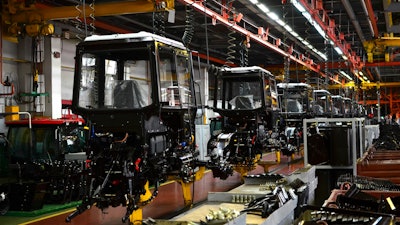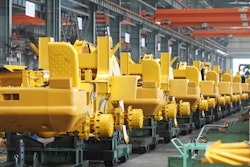
While the economy is expanding, manufacturers continue to struggle with workforce shortages, limited supplies and the largest order backlog since 1993. Economic activity in the manufacturing sector grew in May, with the overall economy notching a 12th consecutive month of growth, say the nation's supply executives in the latest Manufacturing ISM Report on Business.
The Manufacturing PMI, or the Purchasing Managers’ Index, is a set of economic indicators based off surveys of private-sector companies. The report was issued June 1 by Timothy R. Fiore, chair of the Institute for Supply Management (ISM) Manufacturing Business Survey Committee.
"The May Manufacturing PMI registered 61.2%, an increase of 0.5 percentage point from the April reading of 60.7%,” Fiore says. “This figure indicates expansion in the overall economy for the 12th month in a row after contraction in April 2020.”
The ISM report echoes economic news from other sources. The Organisation for Economic Co-operation and Development (OECD), for example, announced May 31 that the economy is set to grow this year at the fastest rate since 1984. The OECD report predicts U.S. gross domestic product will grow 6.9% in 2021.
Most indexes within the ISM report registered slightly higher than the previous month. Manufacturers responding to the survey noted several challenges.
“The manufacturing economy continued expansion in May,” he says. “Business Survey Committee panelists reported that their companies and suppliers continue to struggle to meet increasing levels of demand. Record-long lead times, wide-scale shortages of critical basic materials, rising commodities prices and difficulties in transporting products are continuing to affect all segments of the manufacturing economy. Worker absenteeism, short-term shutdowns due to part shortages, and difficulties in filling open positions continue to be issues that limit manufacturing-growth potential.”
Manufacturers Express Positive Expectations
Optimistic panel sentiment increased, with 36 positive comments for every cautious comment, compared to an 11-to-1 ratio in April. Demand expanded, with the New Orders Index growing at a strong level, supported by the New Export Orders Index continuing to expand, Customers' Inventories Index hitting another all-time low and Backlog of Orders Index continuing at a record-high level.
According to the report, consumption indicated slowing expansion, with a 8.2-percentage point decrease to the Manufacturing PMI calculation. The Employment Index expanded for the sixth straight month, but panelists continue to note significant difficulties in attracting and retaining labor at their companies' and suppliers' facilities. Consumption was limited due to labor issues and supply constraints as demand remains very high, Fiore says.
"All of the six biggest manufacturing industries — computer and electronic products; fabricated metal products; food, beverage and tobacco products; chemical products; transportation equipment; and petroleum and coal products, in that order — registered moderate to strong growth in May,” he says. “Panelists’ companies and their supply chains continue to struggle to respond to strong demand due to the difficulty in hiring and retaining direct labor. Record backlog, customer inventories and raw material lead times are being reported. The manufacturing recovery has transitioned from first addressing demand headwinds, to now overcoming labor obstacles across the entire value chain.”  Institute for Supply Management (ISM)
Institute for Supply Management (ISM)
Sixteen of 18 manufacturing industries reported growth in May, in the following order: furniture and related products; nonmetallic mineral products; plastics and rubber products; textile mills; primary metals; computer and electronic products; electrical equipment, appliances and components; fabricated metal products; food, beverage and tobacco products; machinery; chemical products; miscellaneous manufacturing; transportation equipment; wood products; paper products; and petroleum and coal products. The only industry reporting contraction in May is Printing and related support activities.
“[A] lack of qualified candidates to fill both open office and shop positions is having a negative impact on production throughput,” one fabricated metal business executive reported. “Challenges mounting for meeting delivery dates to customers due to material and services shortages and protracted lead times. This situation does not look to improve until possibly the fourth quarter of 2021 or beyond.”
An executive in computer and electronic products reported, “supplier performance — deliveries, quality, it's all suffering. Demand is high, and we are struggling to find employees to help us keep up.”
READ MORE: Increased Equipment Demand Leads to Positive First Quarter 2021
Commodity Price Changes
Several commodities experienced price increases in May. In parentheses is the number of months prices have been increasing: aluminum (12); aluminum products (2); brass; coatings (2); copper (12); copper products (3); corn; corrugate (8); corrugated boxes (7); diesel (5); electrical components (6); electronic components (6); epoxy resin; fabricated metal components; foam products (3); freight (7); high-density polyethylene (hdpe) (5); hydrochloric acid; labor — temporary; linerboard; low-density polyethylene; lubricants (2); lumber (11); medium-density fiberboard (mdf); natural gas (2); ocean freight (6); packaging supplies (6); paper; paper products (6); plastic containers; plastic resins (9); polyethylene (4); polyethylene terephthalate (pet) products; polypropylene (11); precious metals (2); resin-based products (4); rubber products (4); semiconductors (4); solvents; soybean products (8); steel (10); steel — carbon (6); steel — cold rolled (9); steel — galvanized; steel — hot rolled (9); steel — scrap; steel — stainless (7); steel bars; steel drums; steel products (9); stainless steel components; wire harnesses; wood for pallets (2); and wood — pallets (finished product) (6).
Commodities in short supply include: acrylates; aluminum (2); aluminum products; coatings; corrugated boxes (7); electrical components (8); electronic components (6); foam products (3); labor — temporary; lumber (3); medium-density fiberboard (mdf); nylon fiber (2); ocean freight (2); plastic containers; plastic products (4); plastic resins — other (3); polycarbonates; polyethylene terephthalate (pet) products; polypropylene (2); polyvinyl chloride (pvc) resin; printed circuit boards; printed circuit board assemblies; semiconductors (6); steel (6); steel — cold rolled; steel — galvanized; steel — hot rolled (7); steel — stainless (3); steel bars; steel products (4); steel tubing; and wood — pallets (2).  Institute for Supply Management (ISM)
Institute for Supply Management (ISM)
Employment Challenges
ISM's Employment Index registered 50.9% in May, 4.2 percentage points lower than the April reading of 55.1%. The index grew for the sixth month in a row but only two sectors expanded: fabricated metal products and food, beverage and tobacco products.
“Continued strong new-order levels, low customer inventories and expanding backlogs continue to indicate employment strength. However, survey panelists' companies continue to struggle to meet labor-management plans,” Fiore says. “Panelists' comments indicate an overwhelming majority of their companies are hiring or attempting to hire, with more than 50% of them expressing difficulty in doing so.”
An Employment Index above 50.6%, over time, is generally consistent with an increase in the Bureau of Labor Statistics (BLS) data on manufacturing employment.
Of the 18 manufacturing industries, the nine industries reporting employment growth in May, in order: electrical equipment, appliances and components; textile mills; primary metals; furniture and related products; plastics and rubber products; fabricated metal products; miscellaneous manufacturing; machinery; and food, beverage and tobacco products.
Watch our video interview with Julie Davis, Workforce Development Director, Association of Equipment Manufacturers (AEM) to learn more about the workforce challenges faced by heavy equipment manufacturers.
Supplier Deliveries
Manufacturing companies say they received supplier deliveries more slowly in May than in April. The Supplier Deliveries Index registered at 78.8%, which is 3.8 percentage points higher than the 75% reported in April and the highest reading since April 1974, when the index registered 82.1%. The higher the index, the slower the delivery rate. Five (computer and electronic products; food, beverage and tobacco products; fabricated metal products; transportation equipment; and chemical products) of the six top manufacturing industries reported slowing deliveries.
“Deliveries slowed at a faster rate compared to the previous month,” Fiore says.
The Supplier Deliveries Index reflects difficulties suppliers continue to experience in meeting customer demand, including hiring challenges, longer raw materials lead times and higher prices, as well as product shortages, and limited transportation availability.
“Supplier labor, materials and transportation constraints are not expected to diminish in the second quarter, putting further strain on panelists' production plans and raw-materials inventory accounts,” Fiore says. “Production material lead times are at the highest level since January 1987 when we began recording lead times.”  Institute for Supply Management (ISM)
Institute for Supply Management (ISM)
Inventories
Some companies reported larger inventories in May over April. The Inventories Index registered 50.8% in May, 4.3 percentage points higher than the 46.5% reported for April. The Inventories Index moved back into growth territory after contracting for one month.
"Inventories remain unstable due to ongoing supplier constraints,” Fiore says. “In May, supplier delivery rates were not able to keep up with new-order and production levels, causing lack of expansion of the Inventories Index and a constraint on panelists' companies production levels.”
An Inventories Index greater than 44.5%, over time, is generally consistent with expansion in the Bureau of Economic Analysis (BEA) figures on overall manufacturing inventories (in chained 2000 dollars), according to the report.
The eight industries reporting higher inventories in May are: furniture and related products; textile mills; food, beverage and tobacco products; primary metals; chemical products; computer and electronic products; fabricated metal products; and transportation equipment. The seven industries reporting a decrease in inventories in May are: apparel, leather and allied products; printing and related support activities; nonmetallic mineral products; paper products; miscellaneous manufacturing; machinery; and electrical equipment, appliances and components.
Prices
The ISM Prices Index registered 88%, a decrease of 1.6 percentage points compared to the April reading of 89.6%, indicating raw materials prices increased for the 12th consecutive month. In the last four months, the index has been at its highest levels since July 2008, the last of five straight months over 80%, when it registered 90.4%.
“Virtually all basic and intermediate manufacturing materials are experiencing price increases as a result of product scarcity and the dynamics of supply and demand,” Fiore says.
A Prices Index above 52.7%, over time, is generally consistent with an increase in the Bureau of Labor Statistics (BLS) Producer Price Index for Intermediate Materials.  Institute for Supply Management (ISM)
Institute for Supply Management (ISM)
Backlog of Orders
ISM's Backlog of Orders Index registered 70.6% in May, a 2.4-percentage point increase compared to the 68.2% reported in April, indicating order backlogs expanded for the 11th straight month. May's reading is the highest since reporting for this subindex began in January 1993.
“Backlogs expanded at faster rates in May, indicating 11 months of new-order intakes more than fully offsetting production outputs. Five (fabricated metal products; transportation equipment; chemical products; food, beverage and tobacco products; and computer and electronic products) of the six big industry sectors reported that backlogs expanded strongly,” Fiore says.
The 15 industries reporting growth in order backlogs in May, in the following order, are: apparel, leather and allied products; nonmetallic mineral products; machinery; plastics and rubber products; primary metals; paper products; wood products; furniture and related products; fabricated metal products; transportation equipment; chemical products; food, beverage and tobacco products; electrical equipment, appliances and components; miscellaneous manufacturing; and computer and electronic products.
Imports
Imports were up slightly in May. ISM's Imports Index registered 54%, an increase of 1.8 percentage points compared to the 52.2% reported for April.
“Imports expanded for the 11th consecutive month, at a faster rate compared to April, reflecting continuing increases in U.S. factory demand and some amount of throughput improvement in ports of entry. Overland-transport challenges and container shortages continue to persist across the global supply chain. Imports will continue to be challenged through the third quarter of 2021,” Fiore says.
The 11 industries reporting growth in imports in May are: wood products; nonmetallic mineral products; furniture and related products; textile mills; chemical products; machinery; plastics and rubber products; miscellaneous manufacturing; transportation equipment; fabricated metal products; and computer and electronic products. The three industries reporting a decrease in imports in may are: paper products; primary metals; and food, beverage and tobacco products.





















